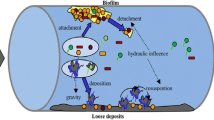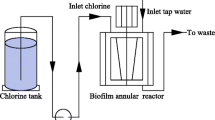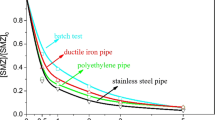Abstract
The impact of orthophosphate addition on biofilm formation and water quality was studied in corrosion-resistant stainless steel (STS) pipe and corrosion-susceptible ductile cast iron (DCI) pipe using cultivation and culture-independent approaches. Sample coupons of DCI pipe and STS pipe were installed in annular reactors, which were operated for 9 months under hydraulic conditions similar to a domestic plumbing system. Addition of 5 mg/L of phosphate to the plumbing systems, under low residual chlorine conditions, promoted a more significant growth of biofilm and led to a greater rate reduction of disinfection by-products in DCI pipe than in STS pipe. While the level of THMs (trihalomethanes) increased under conditions of low biofilm concentration, the levels of HAAs (halo acetic acids) and CH (chloral hydrate) decreased in all cases in proportion to the amount of biofilm. It was also observed that chloroform, the main species of THM, was not readily decomposed biologically and decomposition was not proportional to the biofilm concentration; however, it was easily biodegraded after the addition of phosphate. Analysis of the 16S rDNA sequences of 102 biofilm isolates revealed that Proteobacteria (50%) was the most frequently detected phylum, followed by Firmicutes (10%) and Actinobacteria (2%), with 37% of the bacteria unclassified. Bradyrhizobium was the dominant genus on corroded DCI pipe, while Sphingomonas was predominant on non-corroded STS pipe. Methylobacterium and Afipia were detected only in the reactor without added phosphate. PCR-DGGE analysis showed that the diversity of species in biofilm tended to increase when phosphate was added regardless of the pipe material, indicating that phosphate addition upset the biological stability in the plumbing systems.
Similar content being viewed by others
References
Abernathy, C.G. and Camper, A.K. 1998. The effect of phosphorus based corrosion inhibitors and low disinfectant residuals on distribution biofilms. In Proceedings of Water Quality and Technology Conference. Denver, Colorado, Am. Water Works Assoc.
Ahn, J.H., Kim, Y.J., Kim, T.S., Song, H.G., Kang, C.H., and Ka, J.O. 2009. Quantitative improvement of 16S rDNA DGGE analysis for soil bacterial community using real-time PCR. J. Microbiol. Methods 78, 216–222.
Altschul, S.F., Gish, W., Miller, W., Myers, E.W., and Lipmann, D.J. 1990. Basic local alignment tool. J. Mol. Biol. 215, 403–410.
Annick, D.F., Manuel, J.R., Jean, S., and Francois, P. 2009. Impact of water stagnation in residential cold and hot water plumbing on concentrations of trihalomethanes and haloacetic acids. Water Res. 43, 3057–3066.
APHA, AWWA, WEF. 1998. Standard methods for the examination of water and wastewater. American Public Health Association, American Water Works Association, Water Environment Federation, Washington, D.C., USA.
Appenzeller, B.M.R., Batte, M., Mathieu, L., Block, J.C., Lahoussine, V., Cavard, D., and Gatel, D. 2001. Effect of adding phosphate to drinking water on bacterial growth in slightly and highly corroded pipes. Water Res. 35, 1100–1105.
Appenzeller, B.M.R., Duval, Y.B., Thomas, F., and Block, J.C. 2002. Influence of phosphate on bacterial adhesion onto iron oxyhydroxide in drinking water. Environ. Sci. Technol. 36, 646–652.
Baribeau, H., Krasner, S.W., Chinn, R., and Singer, P.C. 2005. Impact of biomass on the stability of HAAs and THMs. J. Am. Water Works Assoc. 97, 69–81.
Batté, M., Mathieu, L., Laurent, P., and Prévost, M. 2003. Influence of phosphate and disinfection on the composition of biofilms produced from drinking water, as measured by fluorescence in situ hybridization. Can. J. Microbiol. 49, 741–753.
Boks, N.P., Busscher, H.J., van der Mei, H.C., and Norde, W. 2008. Bond-strengthening in staphylococcal adhesion to hydrophilic and hydrophobic surfaces using atomic-force microscopy. Langmuir. 24, 12990–12994.
Butterfield, P.W., Camper, A.K., Ellis, B.D., and Jones, W.L. 2002. Chlorination of model drinking water biofilm: implications for growth and organic carbon removal. Water Res. 36, 4391–4405.
Camper, A.K. 1996. Factors limiting microbial growth in distribution systems: laboratory and pilot-scale experiments. American Water Works Association Reaesrch Foundation, Denver, Colorado.
Camper, A.K., Brastrup, K., Sandvig, A., Clement, J., Spencer, C., and Capuzzi, A.J. 2003. Effect of distribution system materials on bacterial regrowth. J. Am. Water Works Assoc. 95, 107–121.
Chen, W.J. and Weisel, C.P. 1998. Halogenated DBP concentrations in a distribution system. J. Am. Water Works Assoc. 90, 151–163.
Choi, Y.K. and Choi, Y.J. 2010. The effects of UV disinfection on drinking water quality in distribution systems. Water Res. 44, 115–122.
Chu, C., Lu, C., and Lee, C. 2005. Effect of inorganic nutrients on the regrowth of heterotrophic bacteria in drinking water distribution systems. J. Environ. Manage. 74, 255–263.
Corzo, J., Barrios, M.L., Rico, V.H., and Navarro, M.G. 1994. Precipitation of metallic cations by the acidic exopolysaccharides from Bradyrhizobium japonicum and Bradyrhizobium (Chamaecytisus) strain BGA-1. Appl. Environ. Microbiol. 60, 4531–4536.
Critchley, M.M. and Fallowfield, H.J. 2001. The effect of distribution systems bacterial biofilms on copper concentrations in drinking water. Water Sci. Technology: Water Supply. 1, 247–252.
Dudman, W.F. 1976. The extracellular polysaccharides of Rhizobium japonicum: compositional studies. Carbohydr. Res. 46, 97–110.
Fang, W., Hu, J.Y., and Ong, S.L. 2009. Influence of phosphorus on biofilm formation in model drinking water distribution systems. J. Appl. Microbiol. 106, 1328–1335.
Gagnon, G.A. and Slawson, R.M. 1999. An efficient biofilm removal method for bacterial cells exposed to drinking water. J. Microbiol. Methods 34, 203–214.
Gouider, M., Bouzid, J., Sayadi, S., and Montiel, A. 2009. Impact of orthophosphate addition on biofilm development in drinking water distribution systems. J. Hazard Mater. 167, 1198–1202.
Heersink, J.L. 2002. Biofilm protocol manual 3rd ed. MSU Center for Biofilm Engineering, USA.
Hugenholtz, P., Pitulle, C., Hershberger, K.L., and Pace, N.R. 1998. Novel division level bacterial diversity in a Yellowstone hot spring. J. Bacteriol. 180, 366–376.
Jang, H.J., Choi, Y.J., and Ka, J.O. 2011. Effects of diverse water pipe materials on bacterial communities and water quality in the annular reactor. J. Microbiol. Biotechnol. 21, 115–123.
Juhna, T., Birzniece, D., and Janis, R. 2007. Effect of phosphorus on survival of Escherichia coli in drinking water biofilm. Appl. Environ. Microbiol. 73, 3755–3758.
Keinänen, M.M., Korhonen, L.K., Lehtola, M.J., Miettinen, I.T., Martikainen, P.J., Vartianinen, T., and Suutari, M.H. 2002. The microbial community structure of drinking water biofilms can be affected by phosphorus availability. Appl. Environ. Microbiol. 68, 434–439.
Kelly, S.T., Theisen, U., Angenent, L.T., Amand, A.S., and Pace, N.R. 2004. Molecular analysis of shower curtain biofilm microbes. Appl. Environ. Microbiol. 70, 4187–4192.
Kim, T.S., Kim, M.S., Jung, M.K., Ahn, J.H., Joe, M.J., Oh, K.H., Lee, M.H., Kim, M.K., and Ka, J.O. 2005. Analysis of plasmid pJP4 horizontal transfer and its impact on bacterial community structure in natural soil. J. Microbiol. Biotechnol. 15, 376–383.
Krasner, S.W., McGuire, M.J., Jacangelo, J.G., Patania, N.L., Reagan, E.M., and Aieta, E.M. 1989. The occurrence of disinfection by-products in US drinking water. J. Am. Water Works Assoc. 81, 41–53.
Krieg, N.R. and Holt, J.G. 1984. Genus II. Bradyrhizobium, p. 242. In Bergey’s Manual of Systematic Bacteriology, Volume 1. The Williams & Wilkins Co., Baltimore, Maryland, USA.
Kuykendall, L.D., Roy, M.A., O’neill, J.J., and Devine, T.E. 1988. Fatty acids, antibiotic resistance, and deoxyribonucleic acid homology groups of Bradyrhizobiurn japonicum. Int. J. Syst. Bacteriol. 38, 358–361.
Lane, D.J. 1991. 16S/23S rRNA sequencing, pp. 115–148. In Stackebrandt, E. and Goodfellow, M. (eds.), Nucleic Acid Techniques in Bacterial Systematics, John Wiley and Sons, Chichester, England.
LeChevallier, M.W. 1990. Coliform regrowth in drinking water: a review. J. Am. Water Works Assoc. 32, 74–86.
LeChevallier, M.W., Lowry, C.D., Lee, R.G., and Gibbon, D.L. 1993. Examining the relationship between iron corrosion and the disinfection of biofilm bacteria. J. Am. Water Works Assoc. 85, 111–123.
LeChevallier, M.W., Nancy, J.W., and Smith, D.B. 1996. Full-scale studies of factors related to coliforms regrowth in drinking water. Appl. Environ. Microbiol. 62, 2201–2211.
Lehtola, M.J., Miettinen, I.K., and Martikainen, P.J. 2002. Biofilm formation in drinking water affected by low concentrations of phosphorus. Can. J. Microbiol. 48, 494–499.
Lytle, D.A. and Snoeyink, V.L. 2002. Effect of ortho- and polyphosphates on the properties of iron particles and suspensions. J. Am. Water Works Assoc. 94, 87–99.
McLean, R.J.C., Beauchemin, D., and Beveridge, T.J. 1990. Metal-binding characteristics of the gamma-glutamyl capsular polymer of Bacillus licheniformis ATCC 9945. Appl. Environ. Microbiol. 56, 3671–3677.
Mcneill, L.S. and Edwards, M. 2002. Inhibitor use at US utilities. J. Am. Water Works Assoc. 94, 57–63.
McRae, B.M., LaPara, T.M., and Hozalski, R.M. 2004. Biodegradation of haloacetic acids by bacterial enrichment cultures. Chemosphere 55, 915–925.
Miettinen, I.T., Vatiainen, T., and Martikainen, P.J. 1997. Phosphorus and bacterial growth in drinking water. Appl. Environ. Microbiol. 63, 3242–3245.
Nguyen, V.T., Turner, M.S., and Dykes, G.A. 2011. Influence of cell surface hydrophobicity on attachment of Campylobacter to abiotic surfaces. Food Microbiol. 28, 942–950.
Niquette, P., Servais, P., and Savoir, R. 2000. Impacts of pipe materials on densities of fixed bacterial biomass in a drinking water distribution system. Water Res. 34, 1952–1956.
Norton, C.D. and LeChevallier, M.W. 2000. A pilot study of bacteriological population changes through portable water treatment and distribution. Appl. Environ. Microbiol. 66, 268–276.
Olaniran, A. 2001. Aerobic dehalogenation potentials of four bacterial species isolated from soil and sewage sludge. Chemosphere 45, 45–50.
Park, S.K. and Hu, J.Y. 2010. Interaction between phosphorus and biodegradable organic carbon on drinking water biofilm subject to chlorination. J. Appl. Microbiol. 108, 2077–2087.
Percival, S.L. and Walker, J.T. 1999. Portable water and biofilms: a review of the public health implications. Biofouling 14, 99–115.
Percival, S.L., Walker, J.T., and P.R. Hunter. 2000. Microbiological aspects of biofilms and drinking water, pp. 61–78. CRC Press, Washington, D.C., USA.
Persson, P., Nilsson, N., and Sjoberg, S. 1996. Structure and bonding of orthophosphate ions at the iron oxide-aqueous interface. J. Colloid Interface Sci. 177, 263–275.
Rossman, L.A., Brown, R.A., Singer, P.C., and Nucklos, J.R. 2001. DBP formation kinetics in a simulated distribution system. Water Res. 35, 3483–3489.
Sathasivan, A. and Ohgaki, S. 1999. Application of new bacterial regrowth potential method for water distribution system-a clear evidence of phosphorus limitation. Water Res. 33, 137–144.
Schwartz, T., Hoffmann, S., and Obst, U. 1998. Formation and bacterial composition of young, natural biofilms obtained from public bank-filtered drinking water systems. Water Res. 32, 2787–2797.
Singer, P.C., Weinberg, H.S., Kranser, S., Arora, H., and Najm, I. 2002. Realtive dominance of HAAs and THMs in treated drinking water. American Water Works Association Reaesrch Foundation, Denver, Colorado, USA.
Summer, R.S., Hooper, S.M., Shukairy, H.M., Solarik, G., and Owen, D. 1996. Assessing DBP yield: uniform formation conditions. J. Am. Water Works Assoc. 86, 80–93.
Tang, Y., Zhou, C., Ziv-El, M., and Rittmann, B.E. 2011. A pH-control model for heterotrophic and hydrogen-based autotrophic denitrification. Water Res. 45, 232–240.
Torvinen, E., Lehtola, M.J., Martikainen, P.J., and Miettinen, I.T. 2007. Survival of Mycobacterium avium in drinking water biofilms as affected by water flow velocity, availability of phosphorus, and temperature. Appl. Environ. Microbiol. 73, 6201–6207.
Tung, H.H. and Xie, Y.F. 2009. Association between haloacetic acid degradation and heterotrophic bacteria in water distribution systems. Water Res. 43, 971–978.
Van der Kooij, D., Lieverloo, J.H.M., Schellart, J., and Hiemstra, P. 1999. Maintaining quality without a disinfectant residual. J. Am. Water Works Assoc. 91, 55–64.
Van der Kooij, D., Veenendaal, H.R., and Scheffer, W.J.H. 2005. Biofilm formation and multiplication of Legionella in a model warm water system with pipes of copper, stainless steel and cross-linked polyethylene. Water Res. 39, 2789–2795.
Volk, C., Dundore, E., Schiermann, J., and LeChevallier, M. 2000. Practical evaluation of iron corrosion control in a distribution system. Water Res. 34, 1967–1974.
Vrouwenvelder, J.S., Beyer, F., Dahmani, K., Hasan, N., Galjaard, G., Kruithof, J.C., and VanLoosdrecht, M.C.M. 2010. Phosphate limitation to control biofouling. Water Res. 44, 3454–3466.
Wahman, D.G., Katz, L.E., and Gerald, E.S. 2005. Cometabolism of trihalomethanes by Nitrosomonas europaea. Appl. Environ. Microbiol. 71, 7980–7986.
Author information
Authors and Affiliations
Corresponding author
Rights and permissions
About this article
Cite this article
Jang, HJ., Choi, YJ., Ro, HM. et al. Effects of phosphate addition on biofilm bacterial communities and water quality in annular reactors equipped with stainless steel and ductile cast iron pipes. J Microbiol. 50, 17–28 (2012). https://doi.org/10.1007/s12275-012-1040-x
Received:
Accepted:
Published:
Issue Date:
DOI: https://doi.org/10.1007/s12275-012-1040-x




